University Report: Role of HbA1c in Diabetes Diagnosis and Management
VerifiedAdded on 2022/12/23
|15
|3945
|81
Report
AI Summary
This report examines the crucial role of HbA1c (glycated hemoglobin) in the diagnosis of diabetes mellitus, a metabolic disorder characterized by chronic hyperglycemia. The study highlights HbA1c's advantages over traditional methods like Fasting Plasma Glucose (FPG) and the oral glucose tolerance test (OGTT), emphasizing its convenience and reproducibility. It discusses HbA1c's application in diagnosing prediabetes and diabetes, referencing diagnostic cutoffs and comparing its accuracy across different demographics. The report also addresses factors that can influence HbA1c test results, such as conditions affecting red blood cell survival. Furthermore, it explores the relationship between HbA1c levels and diabetes-related complications, including retinopathy and neuropathy, underscoring the importance of early diagnosis and effective management to mitigate long-term health risks. The report also highlights the significance of HbA1c as a key tool in monitoring glycemic control for patients already diagnosed with diabetes.
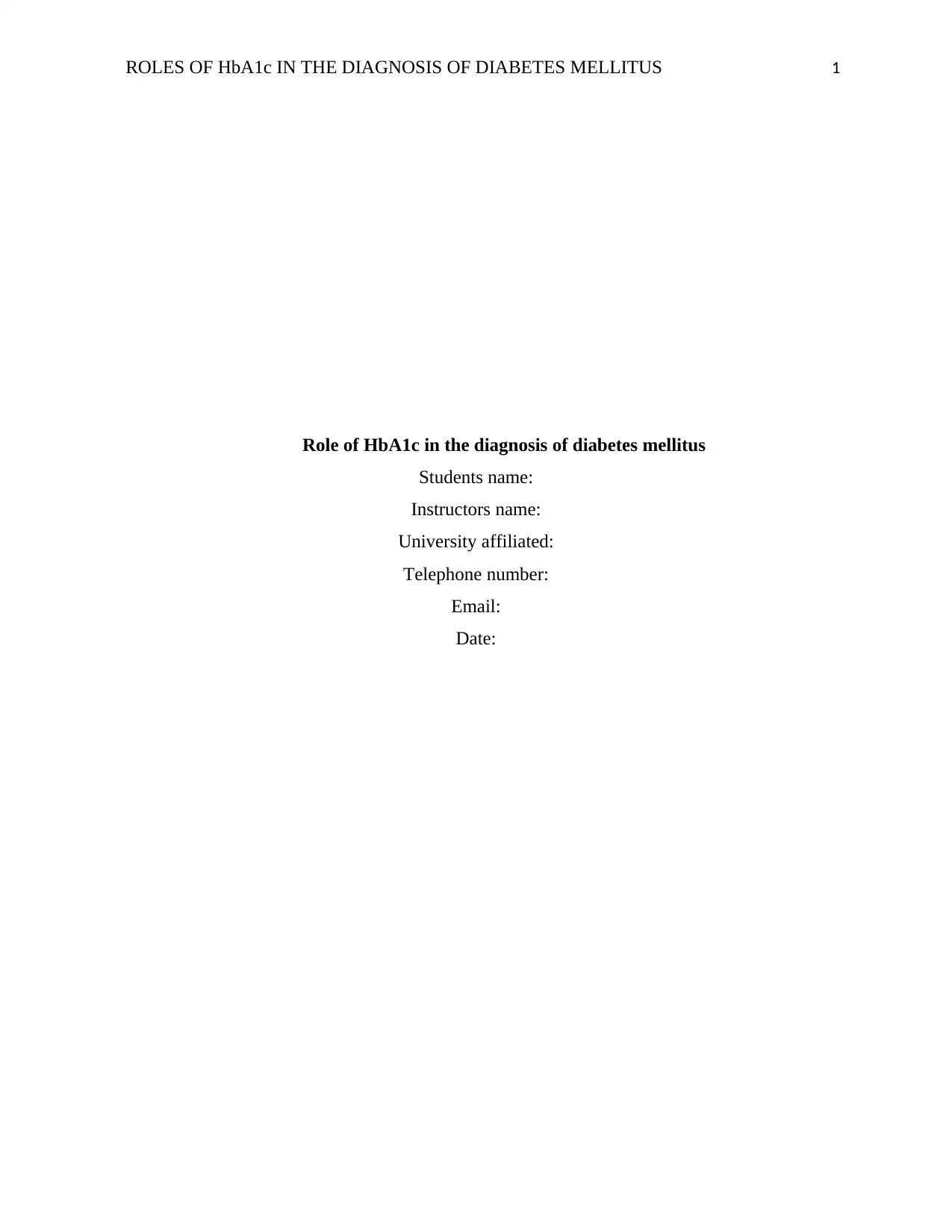
ROLES OF HbA1c IN THE DIAGNOSIS OF DIABETES MELLITUS 1
Role of HbA1c in the diagnosis of diabetes mellitus
Students name:
Instructors name:
University affiliated:
Telephone number:
Email:
Date:
Role of HbA1c in the diagnosis of diabetes mellitus
Students name:
Instructors name:
University affiliated:
Telephone number:
Email:
Date:
Paraphrase This Document
Need a fresh take? Get an instant paraphrase of this document with our AI Paraphraser

ROLES OF HbA1c IN THE DIAGNOSIS OF DIABETES MELLITUS 2
(GLYCATED HAEMOGLOBIN) HbA1C
ABSTRACT
Glycated hemoglobin has campaigned for the diagnosis of prediabetes and diabetes.
HbAc1 performance has been generally assed in confirmation with high Fasting Plasma Glucose
(FPG) but not the mixture of FPG and 2-hr glucose assessment that was recommended by the
ICMJE. The word diabetes mellitus mainly explains metabolic disarray with heterogenous
aetiologies that have been illustrated by chronic hyperglycemia and disorder of carbohydrate.
The long-term consequence of diabetes consists of growth in retinopathy and neuropathy.
Individuals who are affected by this disorder have high chances of getting influenced by cardiac,
peripheral arterial and cerebrovascular illness.
Diabetes and smaller structure of glucose intolerance is found in many individuals around
the world majorly in Australians. However, epidemiological support recommends that, without
helpful strategies of preventing and controlling the programs, the burden of diabetes might tend
to increase worldwide which was recommended by the Association of Clinical Biochemists
(AACB).
Diabetes and the difficulties in it have been the main foundation of mortality and
morbidity worldwide and mainly in the US. This has activated more alerted efforts to determine
and apply optimal advances and criteria that might assist in determining high-risk patients who
are affected with prediabetes and exact diagnosis for patients with diabetes. The concentration of
FPG and the 2-hr glucose that occurs during an oral glucose tolerance test (OGTT) comprises the
customary bases of diagnosis, that are based on the stage that foresee progressive weakening in
glucose tolerance and growth in vascular difficulties. In addition, OGTT usual use as a measure
of chronic HbA1C has been believed for the diagnosis of prediabetes and diabetes, on the
foundation of OGTT relationship to FPG and observed relations between HbA1c and
microvascular and macrovascular difficulties.
INTRODUCTION
HbA1c has been supposed to have benefits over FPG and 2-hr glucose stages due to
advanced convenience and reproducibility, with measurements given that they may be the
measurement can be attained in the non fasted position (BRUNZELL JD, ROBERTSON RP,
LERNER RL, HAZZARD WR, ENSINCK JW, BIERMAN EL2, et al., 2016). These suggestions
(GLYCATED HAEMOGLOBIN) HbA1C
ABSTRACT
Glycated hemoglobin has campaigned for the diagnosis of prediabetes and diabetes.
HbAc1 performance has been generally assed in confirmation with high Fasting Plasma Glucose
(FPG) but not the mixture of FPG and 2-hr glucose assessment that was recommended by the
ICMJE. The word diabetes mellitus mainly explains metabolic disarray with heterogenous
aetiologies that have been illustrated by chronic hyperglycemia and disorder of carbohydrate.
The long-term consequence of diabetes consists of growth in retinopathy and neuropathy.
Individuals who are affected by this disorder have high chances of getting influenced by cardiac,
peripheral arterial and cerebrovascular illness.
Diabetes and smaller structure of glucose intolerance is found in many individuals around
the world majorly in Australians. However, epidemiological support recommends that, without
helpful strategies of preventing and controlling the programs, the burden of diabetes might tend
to increase worldwide which was recommended by the Association of Clinical Biochemists
(AACB).
Diabetes and the difficulties in it have been the main foundation of mortality and
morbidity worldwide and mainly in the US. This has activated more alerted efforts to determine
and apply optimal advances and criteria that might assist in determining high-risk patients who
are affected with prediabetes and exact diagnosis for patients with diabetes. The concentration of
FPG and the 2-hr glucose that occurs during an oral glucose tolerance test (OGTT) comprises the
customary bases of diagnosis, that are based on the stage that foresee progressive weakening in
glucose tolerance and growth in vascular difficulties. In addition, OGTT usual use as a measure
of chronic HbA1C has been believed for the diagnosis of prediabetes and diabetes, on the
foundation of OGTT relationship to FPG and observed relations between HbA1c and
microvascular and macrovascular difficulties.
INTRODUCTION
HbA1c has been supposed to have benefits over FPG and 2-hr glucose stages due to
advanced convenience and reproducibility, with measurements given that they may be the
measurement can be attained in the non fasted position (BRUNZELL JD, ROBERTSON RP,
LERNER RL, HAZZARD WR, ENSINCK JW, BIERMAN EL2, et al., 2016). These suggestions
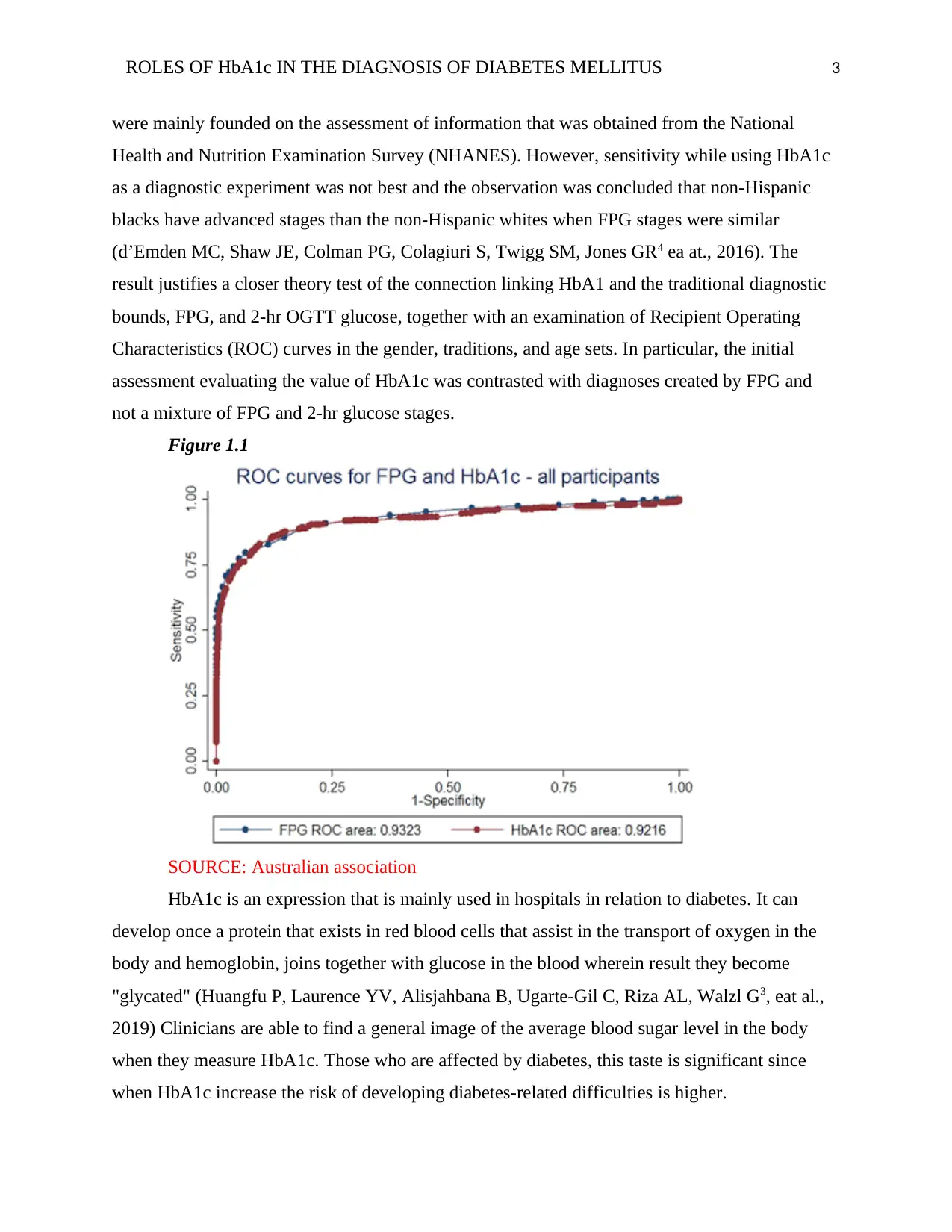
ROLES OF HbA1c IN THE DIAGNOSIS OF DIABETES MELLITUS 3
were mainly founded on the assessment of information that was obtained from the National
Health and Nutrition Examination Survey (NHANES). However, sensitivity while using HbA1c
as a diagnostic experiment was not best and the observation was concluded that non-Hispanic
blacks have advanced stages than the non-Hispanic whites when FPG stages were similar
(d’Emden MC, Shaw JE, Colman PG, Colagiuri S, Twigg SM, Jones GR4 ea at., 2016). The
result justifies a closer theory test of the connection linking HbA1 and the traditional diagnostic
bounds, FPG, and 2-hr OGTT glucose, together with an examination of Recipient Operating
Characteristics (ROC) curves in the gender, traditions, and age sets. In particular, the initial
assessment evaluating the value of HbA1c was contrasted with diagnoses created by FPG and
not a mixture of FPG and 2-hr glucose stages.
Figure 1.1
SOURCE: Australian association
HbA1c is an expression that is mainly used in hospitals in relation to diabetes. It can
develop once a protein that exists in red blood cells that assist in the transport of oxygen in the
body and hemoglobin, joins together with glucose in the blood wherein result they become
"glycated" (Huangfu P, Laurence YV, Alisjahbana B, Ugarte-Gil C, Riza AL, Walzl G3, eat al.,
2019) Clinicians are able to find a general image of the average blood sugar level in the body
when they measure HbA1c. Those who are affected by diabetes, this taste is significant since
when HbA1c increase the risk of developing diabetes-related difficulties is higher.
were mainly founded on the assessment of information that was obtained from the National
Health and Nutrition Examination Survey (NHANES). However, sensitivity while using HbA1c
as a diagnostic experiment was not best and the observation was concluded that non-Hispanic
blacks have advanced stages than the non-Hispanic whites when FPG stages were similar
(d’Emden MC, Shaw JE, Colman PG, Colagiuri S, Twigg SM, Jones GR4 ea at., 2016). The
result justifies a closer theory test of the connection linking HbA1 and the traditional diagnostic
bounds, FPG, and 2-hr OGTT glucose, together with an examination of Recipient Operating
Characteristics (ROC) curves in the gender, traditions, and age sets. In particular, the initial
assessment evaluating the value of HbA1c was contrasted with diagnoses created by FPG and
not a mixture of FPG and 2-hr glucose stages.
Figure 1.1
SOURCE: Australian association
HbA1c is an expression that is mainly used in hospitals in relation to diabetes. It can
develop once a protein that exists in red blood cells that assist in the transport of oxygen in the
body and hemoglobin, joins together with glucose in the blood wherein result they become
"glycated" (Huangfu P, Laurence YV, Alisjahbana B, Ugarte-Gil C, Riza AL, Walzl G3, eat al.,
2019) Clinicians are able to find a general image of the average blood sugar level in the body
when they measure HbA1c. Those who are affected by diabetes, this taste is significant since
when HbA1c increase the risk of developing diabetes-related difficulties is higher.
⊘ This is a preview!⊘
Do you want full access?
Subscribe today to unlock all pages.

Trusted by 1+ million students worldwide

ROLES OF HbA1c IN THE DIAGNOSIS OF DIABETES MELLITUS 4
HbA1c in diagnosis
In diagnosis, 48 mmol/mol (6.5) is a general target that everyone should be targeting. On
the other hand, people diabetes should be given their own target. Below is a table clearly
showing how HbA1c may specify either those with diabetes or prediabetes.
Table 1.2
Diagnosis and monitoring diabetes
Diabetes mellitus has been a common division of metabolic disorder that has a global
occurrence of 8.5% in 2004 0r around 422 million people who have been affected. Distinguished
by common episodes of uncontrolled hyperglycemia, this disorder is divided into two major
types that are either type 1 or 2. Type one of his disorder is distinguished by a deficiency of
insulin production from the pancreas that may lead to uncontrolled blood glucose levels in the
body (World Health Organization, 2016). On the contrary, type 2 diabetes is familiar to people
that entails insufficient insulin production by the pancreas or cells in the body struggling to
acquire the action of insulin.
Table 1.3
Diagnostic measure for diabetes mellitus
Diagnostic Test Cut off remarks
AIC ≥7.5 ….
Fasting plasma glucose ≥127mg For less that 8hrs there is no intake
2-hr plasma glucose ≥201mg Glucose in H2O after every 75g
Random plasma glucose ≥201mg Majorly appear in individuals with signs
HbA1c mmol/mol percentage (%)
Normal 42 and below 6.0 and below
Prediabetes 42-47 6.0-6.4
Diabetes 48 and above over 6.5
HbA1c in diagnosis
In diagnosis, 48 mmol/mol (6.5) is a general target that everyone should be targeting. On
the other hand, people diabetes should be given their own target. Below is a table clearly
showing how HbA1c may specify either those with diabetes or prediabetes.
Table 1.2
Diagnosis and monitoring diabetes
Diabetes mellitus has been a common division of metabolic disorder that has a global
occurrence of 8.5% in 2004 0r around 422 million people who have been affected. Distinguished
by common episodes of uncontrolled hyperglycemia, this disorder is divided into two major
types that are either type 1 or 2. Type one of his disorder is distinguished by a deficiency of
insulin production from the pancreas that may lead to uncontrolled blood glucose levels in the
body (World Health Organization, 2016). On the contrary, type 2 diabetes is familiar to people
that entails insufficient insulin production by the pancreas or cells in the body struggling to
acquire the action of insulin.
Table 1.3
Diagnostic measure for diabetes mellitus
Diagnostic Test Cut off remarks
AIC ≥7.5 ….
Fasting plasma glucose ≥127mg For less that 8hrs there is no intake
2-hr plasma glucose ≥201mg Glucose in H2O after every 75g
Random plasma glucose ≥201mg Majorly appear in individuals with signs
HbA1c mmol/mol percentage (%)
Normal 42 and below 6.0 and below
Prediabetes 42-47 6.0-6.4
Diabetes 48 and above over 6.5
Paraphrase This Document
Need a fresh take? Get an instant paraphrase of this document with our AI Paraphraser
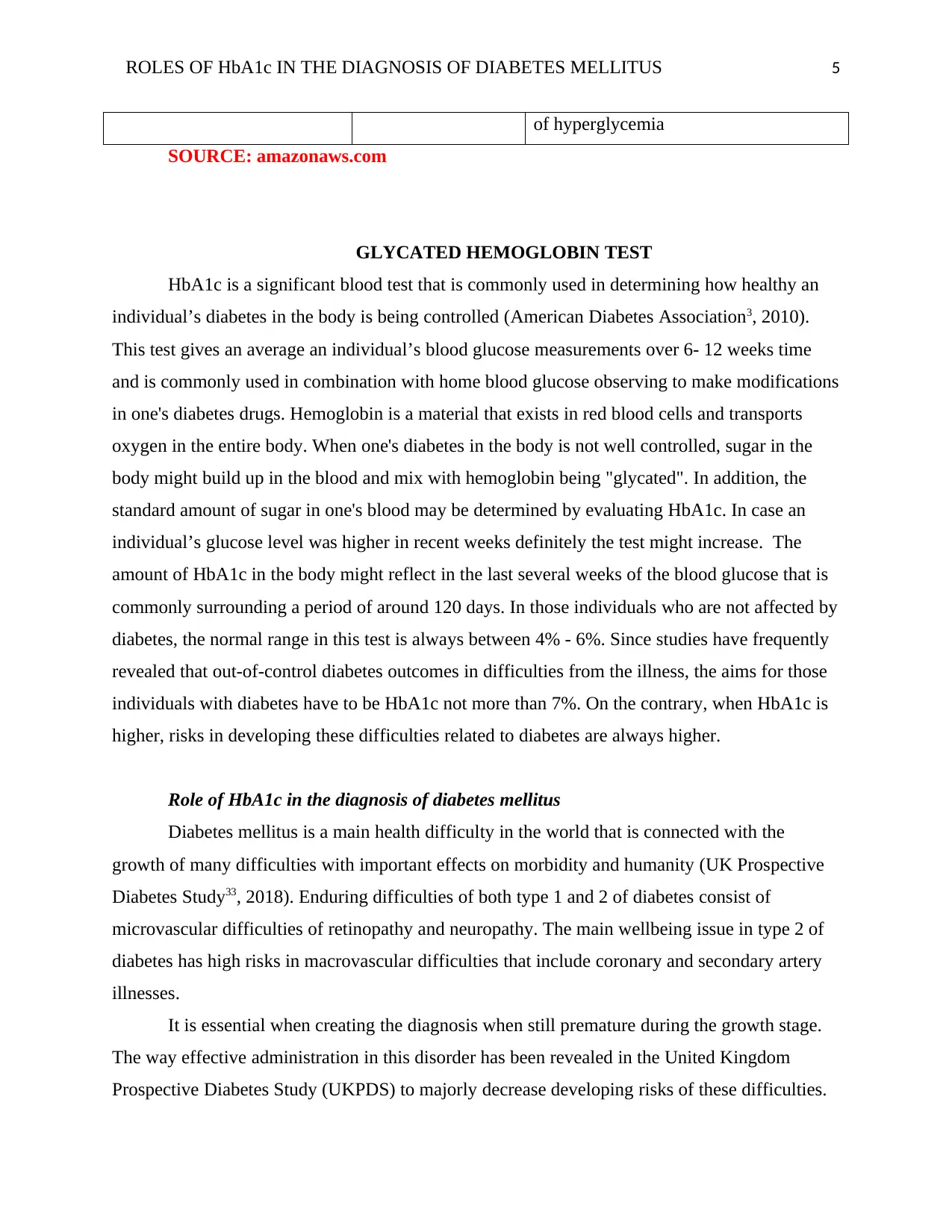
ROLES OF HbA1c IN THE DIAGNOSIS OF DIABETES MELLITUS 5
of hyperglycemia
SOURCE: amazonaws.com
GLYCATED HEMOGLOBIN TEST
HbA1c is a significant blood test that is commonly used in determining how healthy an
individual’s diabetes in the body is being controlled (American Diabetes Association3, 2010).
This test gives an average an individual’s blood glucose measurements over 6- 12 weeks time
and is commonly used in combination with home blood glucose observing to make modifications
in one's diabetes drugs. Hemoglobin is a material that exists in red blood cells and transports
oxygen in the entire body. When one's diabetes in the body is not well controlled, sugar in the
body might build up in the blood and mix with hemoglobin being "glycated". In addition, the
standard amount of sugar in one's blood may be determined by evaluating HbA1c. In case an
individual’s glucose level was higher in recent weeks definitely the test might increase. The
amount of HbA1c in the body might reflect in the last several weeks of the blood glucose that is
commonly surrounding a period of around 120 days. In those individuals who are not affected by
diabetes, the normal range in this test is always between 4% - 6%. Since studies have frequently
revealed that out-of-control diabetes outcomes in difficulties from the illness, the aims for those
individuals with diabetes have to be HbA1c not more than 7%. On the contrary, when HbA1c is
higher, risks in developing these difficulties related to diabetes are always higher.
Role of HbA1c in the diagnosis of diabetes mellitus
Diabetes mellitus is a main health difficulty in the world that is connected with the
growth of many difficulties with important effects on morbidity and humanity (UK Prospective
Diabetes Study33, 2018). Enduring difficulties of both type 1 and 2 of diabetes consist of
microvascular difficulties of retinopathy and neuropathy. The main wellbeing issue in type 2 of
diabetes has high risks in macrovascular difficulties that include coronary and secondary artery
illnesses.
It is essential when creating the diagnosis when still premature during the growth stage.
The way effective administration in this disorder has been revealed in the United Kingdom
Prospective Diabetes Study (UKPDS) to majorly decrease developing risks of these difficulties.
of hyperglycemia
SOURCE: amazonaws.com
GLYCATED HEMOGLOBIN TEST
HbA1c is a significant blood test that is commonly used in determining how healthy an
individual’s diabetes in the body is being controlled (American Diabetes Association3, 2010).
This test gives an average an individual’s blood glucose measurements over 6- 12 weeks time
and is commonly used in combination with home blood glucose observing to make modifications
in one's diabetes drugs. Hemoglobin is a material that exists in red blood cells and transports
oxygen in the entire body. When one's diabetes in the body is not well controlled, sugar in the
body might build up in the blood and mix with hemoglobin being "glycated". In addition, the
standard amount of sugar in one's blood may be determined by evaluating HbA1c. In case an
individual’s glucose level was higher in recent weeks definitely the test might increase. The
amount of HbA1c in the body might reflect in the last several weeks of the blood glucose that is
commonly surrounding a period of around 120 days. In those individuals who are not affected by
diabetes, the normal range in this test is always between 4% - 6%. Since studies have frequently
revealed that out-of-control diabetes outcomes in difficulties from the illness, the aims for those
individuals with diabetes have to be HbA1c not more than 7%. On the contrary, when HbA1c is
higher, risks in developing these difficulties related to diabetes are always higher.
Role of HbA1c in the diagnosis of diabetes mellitus
Diabetes mellitus is a main health difficulty in the world that is connected with the
growth of many difficulties with important effects on morbidity and humanity (UK Prospective
Diabetes Study33, 2018). Enduring difficulties of both type 1 and 2 of diabetes consist of
microvascular difficulties of retinopathy and neuropathy. The main wellbeing issue in type 2 of
diabetes has high risks in macrovascular difficulties that include coronary and secondary artery
illnesses.
It is essential when creating the diagnosis when still premature during the growth stage.
The way effective administration in this disorder has been revealed in the United Kingdom
Prospective Diabetes Study (UKPDS) to majorly decrease developing risks of these difficulties.
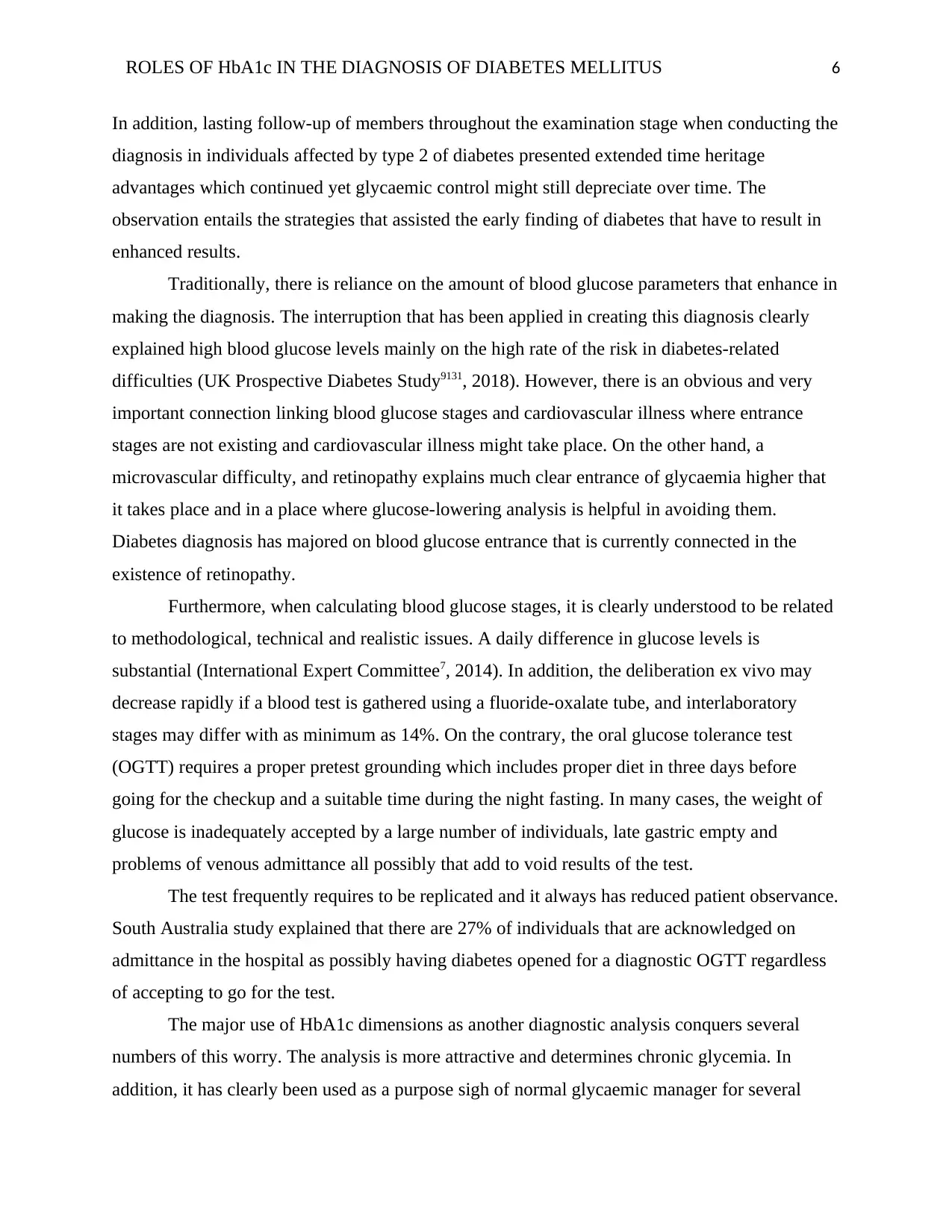
ROLES OF HbA1c IN THE DIAGNOSIS OF DIABETES MELLITUS 6
In addition, lasting follow-up of members throughout the examination stage when conducting the
diagnosis in individuals affected by type 2 of diabetes presented extended time heritage
advantages which continued yet glycaemic control might still depreciate over time. The
observation entails the strategies that assisted the early finding of diabetes that have to result in
enhanced results.
Traditionally, there is reliance on the amount of blood glucose parameters that enhance in
making the diagnosis. The interruption that has been applied in creating this diagnosis clearly
explained high blood glucose levels mainly on the high rate of the risk in diabetes-related
difficulties (UK Prospective Diabetes Study9131, 2018). However, there is an obvious and very
important connection linking blood glucose stages and cardiovascular illness where entrance
stages are not existing and cardiovascular illness might take place. On the other hand, a
microvascular difficulty, and retinopathy explains much clear entrance of glycaemia higher that
it takes place and in a place where glucose-lowering analysis is helpful in avoiding them.
Diabetes diagnosis has majored on blood glucose entrance that is currently connected in the
existence of retinopathy.
Furthermore, when calculating blood glucose stages, it is clearly understood to be related
to methodological, technical and realistic issues. A daily difference in glucose levels is
substantial (International Expert Committee7, 2014). In addition, the deliberation ex vivo may
decrease rapidly if a blood test is gathered using a fluoride-oxalate tube, and interlaboratory
stages may differ with as minimum as 14%. On the contrary, the oral glucose tolerance test
(OGTT) requires a proper pretest grounding which includes proper diet in three days before
going for the checkup and a suitable time during the night fasting. In many cases, the weight of
glucose is inadequately accepted by a large number of individuals, late gastric empty and
problems of venous admittance all possibly that add to void results of the test.
The test frequently requires to be replicated and it always has reduced patient observance.
South Australia study explained that there are 27% of individuals that are acknowledged on
admittance in the hospital as possibly having diabetes opened for a diagnostic OGTT regardless
of accepting to go for the test.
The major use of HbA1c dimensions as another diagnostic analysis conquers several
numbers of this worry. The analysis is more attractive and determines chronic glycemia. In
addition, it has clearly been used as a purpose sigh of normal glycaemic manager for several
In addition, lasting follow-up of members throughout the examination stage when conducting the
diagnosis in individuals affected by type 2 of diabetes presented extended time heritage
advantages which continued yet glycaemic control might still depreciate over time. The
observation entails the strategies that assisted the early finding of diabetes that have to result in
enhanced results.
Traditionally, there is reliance on the amount of blood glucose parameters that enhance in
making the diagnosis. The interruption that has been applied in creating this diagnosis clearly
explained high blood glucose levels mainly on the high rate of the risk in diabetes-related
difficulties (UK Prospective Diabetes Study9131, 2018). However, there is an obvious and very
important connection linking blood glucose stages and cardiovascular illness where entrance
stages are not existing and cardiovascular illness might take place. On the other hand, a
microvascular difficulty, and retinopathy explains much clear entrance of glycaemia higher that
it takes place and in a place where glucose-lowering analysis is helpful in avoiding them.
Diabetes diagnosis has majored on blood glucose entrance that is currently connected in the
existence of retinopathy.
Furthermore, when calculating blood glucose stages, it is clearly understood to be related
to methodological, technical and realistic issues. A daily difference in glucose levels is
substantial (International Expert Committee7, 2014). In addition, the deliberation ex vivo may
decrease rapidly if a blood test is gathered using a fluoride-oxalate tube, and interlaboratory
stages may differ with as minimum as 14%. On the contrary, the oral glucose tolerance test
(OGTT) requires a proper pretest grounding which includes proper diet in three days before
going for the checkup and a suitable time during the night fasting. In many cases, the weight of
glucose is inadequately accepted by a large number of individuals, late gastric empty and
problems of venous admittance all possibly that add to void results of the test.
The test frequently requires to be replicated and it always has reduced patient observance.
South Australia study explained that there are 27% of individuals that are acknowledged on
admittance in the hospital as possibly having diabetes opened for a diagnostic OGTT regardless
of accepting to go for the test.
The major use of HbA1c dimensions as another diagnostic analysis conquers several
numbers of this worry. The analysis is more attractive and determines chronic glycemia. In
addition, it has clearly been used as a purpose sigh of normal glycaemic manager for several
⊘ This is a preview!⊘
Do you want full access?
Subscribe today to unlock all pages.

Trusted by 1+ million students worldwide
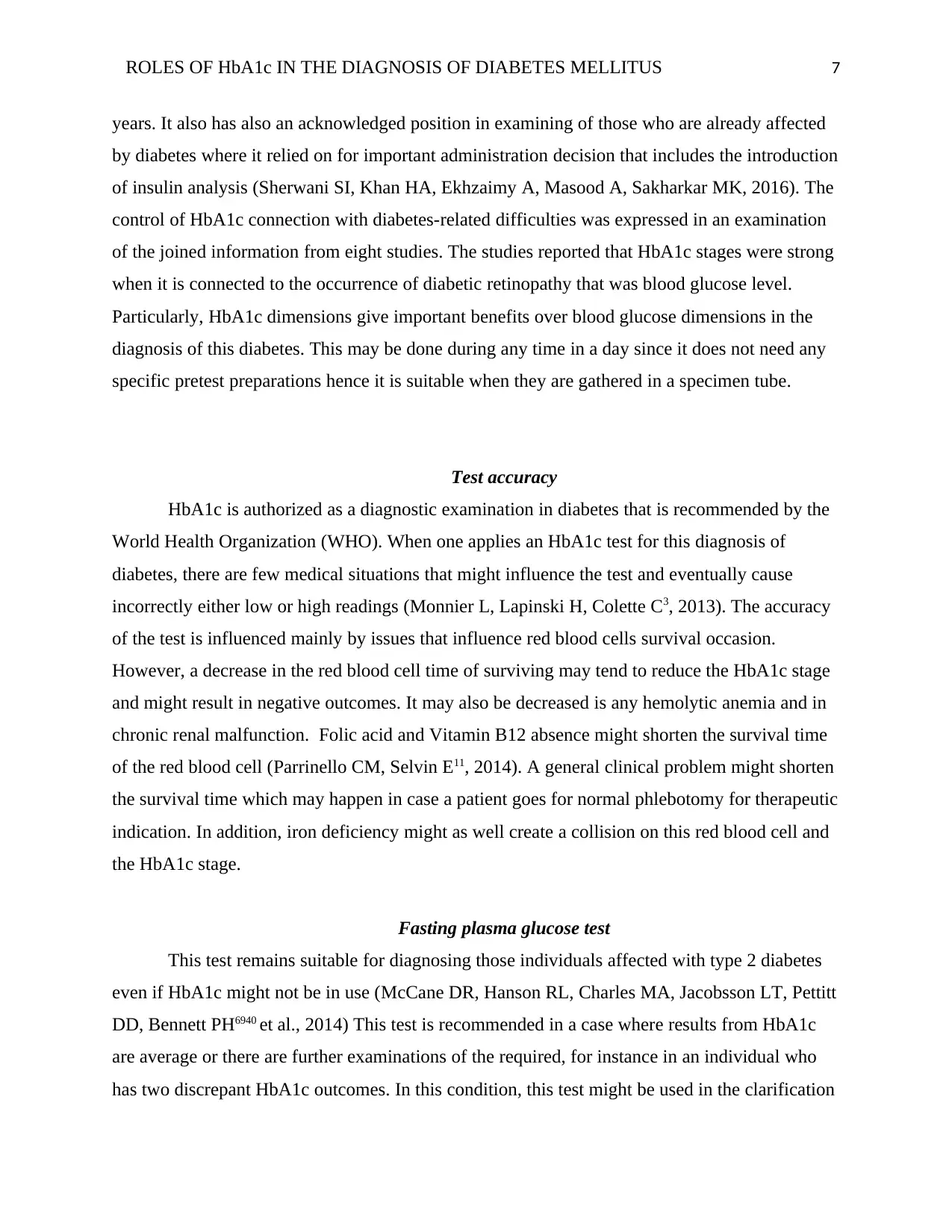
ROLES OF HbA1c IN THE DIAGNOSIS OF DIABETES MELLITUS 7
years. It also has also an acknowledged position in examining of those who are already affected
by diabetes where it relied on for important administration decision that includes the introduction
of insulin analysis (Sherwani SI, Khan HA, Ekhzaimy A, Masood A, Sakharkar MK, 2016). The
control of HbA1c connection with diabetes-related difficulties was expressed in an examination
of the joined information from eight studies. The studies reported that HbA1c stages were strong
when it is connected to the occurrence of diabetic retinopathy that was blood glucose level.
Particularly, HbA1c dimensions give important benefits over blood glucose dimensions in the
diagnosis of this diabetes. This may be done during any time in a day since it does not need any
specific pretest preparations hence it is suitable when they are gathered in a specimen tube.
Test accuracy
HbA1c is authorized as a diagnostic examination in diabetes that is recommended by the
World Health Organization (WHO). When one applies an HbA1c test for this diagnosis of
diabetes, there are few medical situations that might influence the test and eventually cause
incorrectly either low or high readings (Monnier L, Lapinski H, Colette C3, 2013). The accuracy
of the test is influenced mainly by issues that influence red blood cells survival occasion.
However, a decrease in the red blood cell time of surviving may tend to reduce the HbA1c stage
and might result in negative outcomes. It may also be decreased is any hemolytic anemia and in
chronic renal malfunction. Folic acid and Vitamin B12 absence might shorten the survival time
of the red blood cell (Parrinello CM, Selvin E11, 2014). A general clinical problem might shorten
the survival time which may happen in case a patient goes for normal phlebotomy for therapeutic
indication. In addition, iron deficiency might as well create a collision on this red blood cell and
the HbA1c stage.
Fasting plasma glucose test
This test remains suitable for diagnosing those individuals affected with type 2 diabetes
even if HbA1c might not be in use (McCane DR, Hanson RL, Charles MA, Jacobsson LT, Pettitt
DD, Bennett PH6940 et al., 2014) This test is recommended in a case where results from HbA1c
are average or there are further examinations of the required, for instance in an individual who
has two discrepant HbA1c outcomes. In this condition, this test might be used in the clarification
years. It also has also an acknowledged position in examining of those who are already affected
by diabetes where it relied on for important administration decision that includes the introduction
of insulin analysis (Sherwani SI, Khan HA, Ekhzaimy A, Masood A, Sakharkar MK, 2016). The
control of HbA1c connection with diabetes-related difficulties was expressed in an examination
of the joined information from eight studies. The studies reported that HbA1c stages were strong
when it is connected to the occurrence of diabetic retinopathy that was blood glucose level.
Particularly, HbA1c dimensions give important benefits over blood glucose dimensions in the
diagnosis of this diabetes. This may be done during any time in a day since it does not need any
specific pretest preparations hence it is suitable when they are gathered in a specimen tube.
Test accuracy
HbA1c is authorized as a diagnostic examination in diabetes that is recommended by the
World Health Organization (WHO). When one applies an HbA1c test for this diagnosis of
diabetes, there are few medical situations that might influence the test and eventually cause
incorrectly either low or high readings (Monnier L, Lapinski H, Colette C3, 2013). The accuracy
of the test is influenced mainly by issues that influence red blood cells survival occasion.
However, a decrease in the red blood cell time of surviving may tend to reduce the HbA1c stage
and might result in negative outcomes. It may also be decreased is any hemolytic anemia and in
chronic renal malfunction. Folic acid and Vitamin B12 absence might shorten the survival time
of the red blood cell (Parrinello CM, Selvin E11, 2014). A general clinical problem might shorten
the survival time which may happen in case a patient goes for normal phlebotomy for therapeutic
indication. In addition, iron deficiency might as well create a collision on this red blood cell and
the HbA1c stage.
Fasting plasma glucose test
This test remains suitable for diagnosing those individuals affected with type 2 diabetes
even if HbA1c might not be in use (McCane DR, Hanson RL, Charles MA, Jacobsson LT, Pettitt
DD, Bennett PH6940 et al., 2014) This test is recommended in a case where results from HbA1c
are average or there are further examinations of the required, for instance in an individual who
has two discrepant HbA1c outcomes. In this condition, this test might be used in the clarification
Paraphrase This Document
Need a fresh take? Get an instant paraphrase of this document with our AI Paraphraser
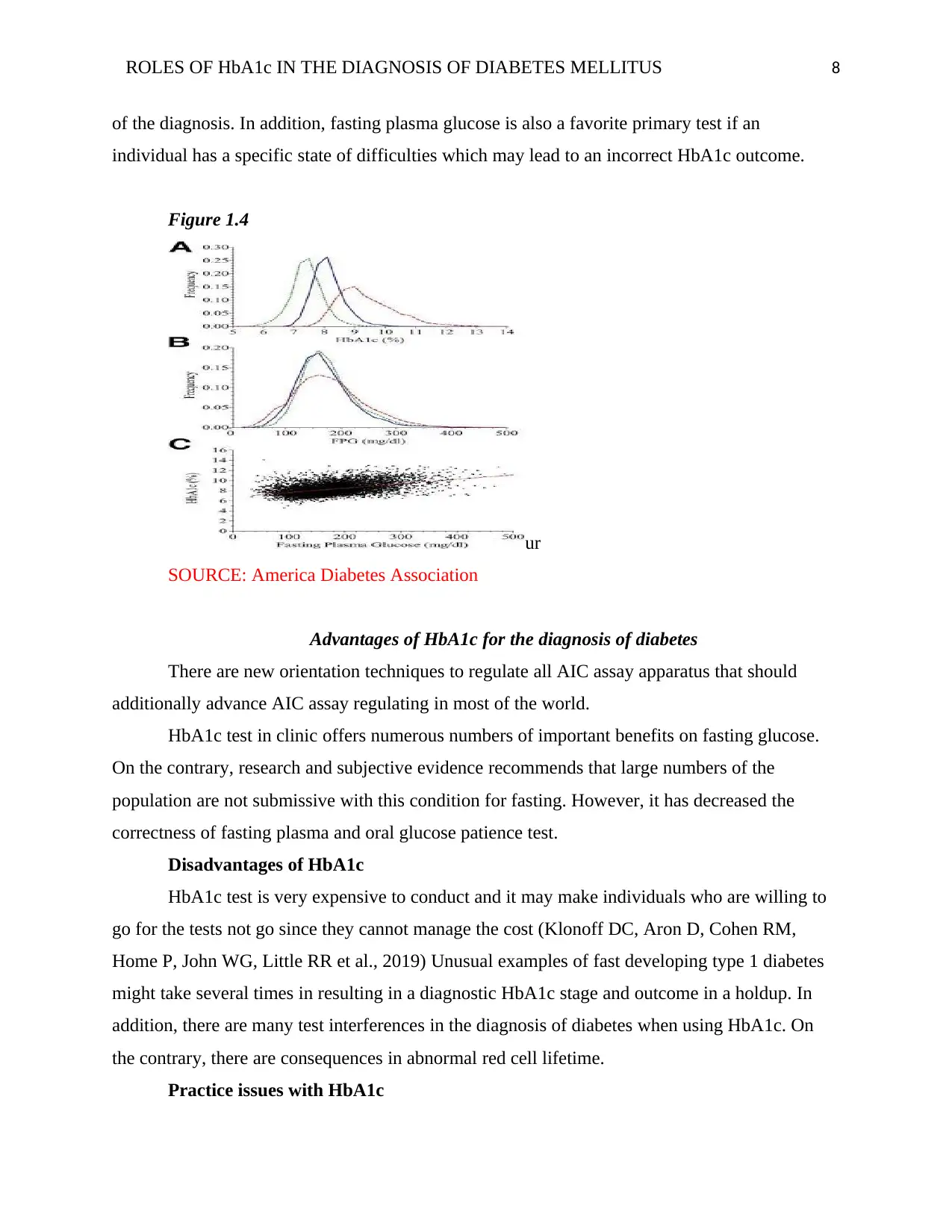
ROLES OF HbA1c IN THE DIAGNOSIS OF DIABETES MELLITUS 8
of the diagnosis. In addition, fasting plasma glucose is also a favorite primary test if an
individual has a specific state of difficulties which may lead to an incorrect HbA1c outcome.
Figure 1.4
ur
SOURCE: America Diabetes Association
Advantages of HbA1c for the diagnosis of diabetes
There are new orientation techniques to regulate all AIC assay apparatus that should
additionally advance AIC assay regulating in most of the world.
HbA1c test in clinic offers numerous numbers of important benefits on fasting glucose.
On the contrary, research and subjective evidence recommends that large numbers of the
population are not submissive with this condition for fasting. However, it has decreased the
correctness of fasting plasma and oral glucose patience test.
Disadvantages of HbA1c
HbA1c test is very expensive to conduct and it may make individuals who are willing to
go for the tests not go since they cannot manage the cost (Klonoff DC, Aron D, Cohen RM,
Home P, John WG, Little RR et al., 2019) Unusual examples of fast developing type 1 diabetes
might take several times in resulting in a diagnostic HbA1c stage and outcome in a holdup. In
addition, there are many test interferences in the diagnosis of diabetes when using HbA1c. On
the contrary, there are consequences in abnormal red cell lifetime.
Practice issues with HbA1c
of the diagnosis. In addition, fasting plasma glucose is also a favorite primary test if an
individual has a specific state of difficulties which may lead to an incorrect HbA1c outcome.
Figure 1.4
ur
SOURCE: America Diabetes Association
Advantages of HbA1c for the diagnosis of diabetes
There are new orientation techniques to regulate all AIC assay apparatus that should
additionally advance AIC assay regulating in most of the world.
HbA1c test in clinic offers numerous numbers of important benefits on fasting glucose.
On the contrary, research and subjective evidence recommends that large numbers of the
population are not submissive with this condition for fasting. However, it has decreased the
correctness of fasting plasma and oral glucose patience test.
Disadvantages of HbA1c
HbA1c test is very expensive to conduct and it may make individuals who are willing to
go for the tests not go since they cannot manage the cost (Klonoff DC, Aron D, Cohen RM,
Home P, John WG, Little RR et al., 2019) Unusual examples of fast developing type 1 diabetes
might take several times in resulting in a diagnostic HbA1c stage and outcome in a holdup. In
addition, there are many test interferences in the diagnosis of diabetes when using HbA1c. On
the contrary, there are consequences in abnormal red cell lifetime.
Practice issues with HbA1c
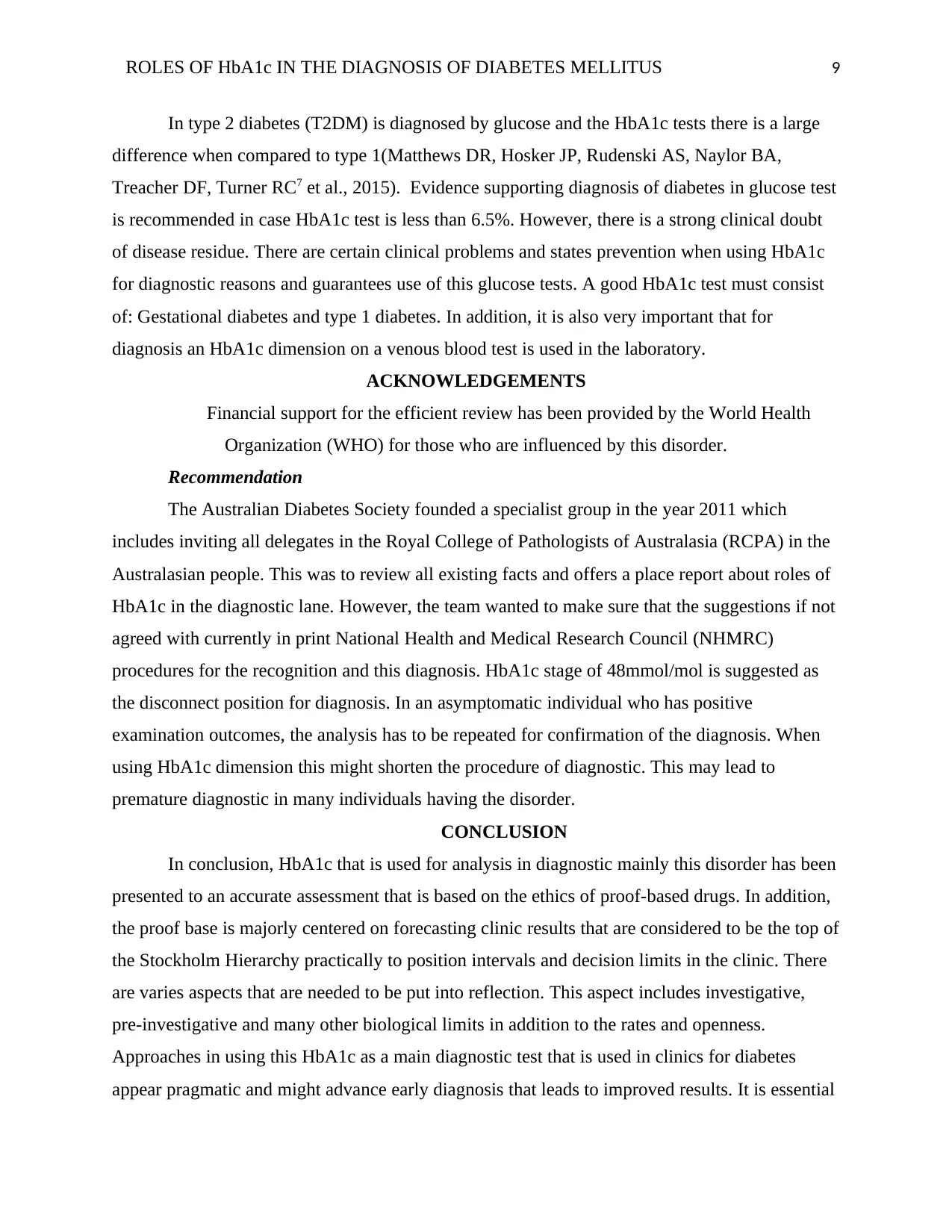
ROLES OF HbA1c IN THE DIAGNOSIS OF DIABETES MELLITUS 9
In type 2 diabetes (T2DM) is diagnosed by glucose and the HbA1c tests there is a large
difference when compared to type 1(Matthews DR, Hosker JP, Rudenski AS, Naylor BA,
Treacher DF, Turner RC7 et al., 2015). Evidence supporting diagnosis of diabetes in glucose test
is recommended in case HbA1c test is less than 6.5%. However, there is a strong clinical doubt
of disease residue. There are certain clinical problems and states prevention when using HbA1c
for diagnostic reasons and guarantees use of this glucose tests. A good HbA1c test must consist
of: Gestational diabetes and type 1 diabetes. In addition, it is also very important that for
diagnosis an HbA1c dimension on a venous blood test is used in the laboratory.
ACKNOWLEDGEMENTS
Financial support for the efficient review has been provided by the World Health
Organization (WHO) for those who are influenced by this disorder.
Recommendation
The Australian Diabetes Society founded a specialist group in the year 2011 which
includes inviting all delegates in the Royal College of Pathologists of Australasia (RCPA) in the
Australasian people. This was to review all existing facts and offers a place report about roles of
HbA1c in the diagnostic lane. However, the team wanted to make sure that the suggestions if not
agreed with currently in print National Health and Medical Research Council (NHMRC)
procedures for the recognition and this diagnosis. HbA1c stage of 48mmol/mol is suggested as
the disconnect position for diagnosis. In an asymptomatic individual who has positive
examination outcomes, the analysis has to be repeated for confirmation of the diagnosis. When
using HbA1c dimension this might shorten the procedure of diagnostic. This may lead to
premature diagnostic in many individuals having the disorder.
CONCLUSION
In conclusion, HbA1c that is used for analysis in diagnostic mainly this disorder has been
presented to an accurate assessment that is based on the ethics of proof-based drugs. In addition,
the proof base is majorly centered on forecasting clinic results that are considered to be the top of
the Stockholm Hierarchy practically to position intervals and decision limits in the clinic. There
are varies aspects that are needed to be put into reflection. This aspect includes investigative,
pre-investigative and many other biological limits in addition to the rates and openness.
Approaches in using this HbA1c as a main diagnostic test that is used in clinics for diabetes
appear pragmatic and might advance early diagnosis that leads to improved results. It is essential
In type 2 diabetes (T2DM) is diagnosed by glucose and the HbA1c tests there is a large
difference when compared to type 1(Matthews DR, Hosker JP, Rudenski AS, Naylor BA,
Treacher DF, Turner RC7 et al., 2015). Evidence supporting diagnosis of diabetes in glucose test
is recommended in case HbA1c test is less than 6.5%. However, there is a strong clinical doubt
of disease residue. There are certain clinical problems and states prevention when using HbA1c
for diagnostic reasons and guarantees use of this glucose tests. A good HbA1c test must consist
of: Gestational diabetes and type 1 diabetes. In addition, it is also very important that for
diagnosis an HbA1c dimension on a venous blood test is used in the laboratory.
ACKNOWLEDGEMENTS
Financial support for the efficient review has been provided by the World Health
Organization (WHO) for those who are influenced by this disorder.
Recommendation
The Australian Diabetes Society founded a specialist group in the year 2011 which
includes inviting all delegates in the Royal College of Pathologists of Australasia (RCPA) in the
Australasian people. This was to review all existing facts and offers a place report about roles of
HbA1c in the diagnostic lane. However, the team wanted to make sure that the suggestions if not
agreed with currently in print National Health and Medical Research Council (NHMRC)
procedures for the recognition and this diagnosis. HbA1c stage of 48mmol/mol is suggested as
the disconnect position for diagnosis. In an asymptomatic individual who has positive
examination outcomes, the analysis has to be repeated for confirmation of the diagnosis. When
using HbA1c dimension this might shorten the procedure of diagnostic. This may lead to
premature diagnostic in many individuals having the disorder.
CONCLUSION
In conclusion, HbA1c that is used for analysis in diagnostic mainly this disorder has been
presented to an accurate assessment that is based on the ethics of proof-based drugs. In addition,
the proof base is majorly centered on forecasting clinic results that are considered to be the top of
the Stockholm Hierarchy practically to position intervals and decision limits in the clinic. There
are varies aspects that are needed to be put into reflection. This aspect includes investigative,
pre-investigative and many other biological limits in addition to the rates and openness.
Approaches in using this HbA1c as a main diagnostic test that is used in clinics for diabetes
appear pragmatic and might advance early diagnosis that leads to improved results. It is essential
⊘ This is a preview!⊘
Do you want full access?
Subscribe today to unlock all pages.

Trusted by 1+ million students worldwide
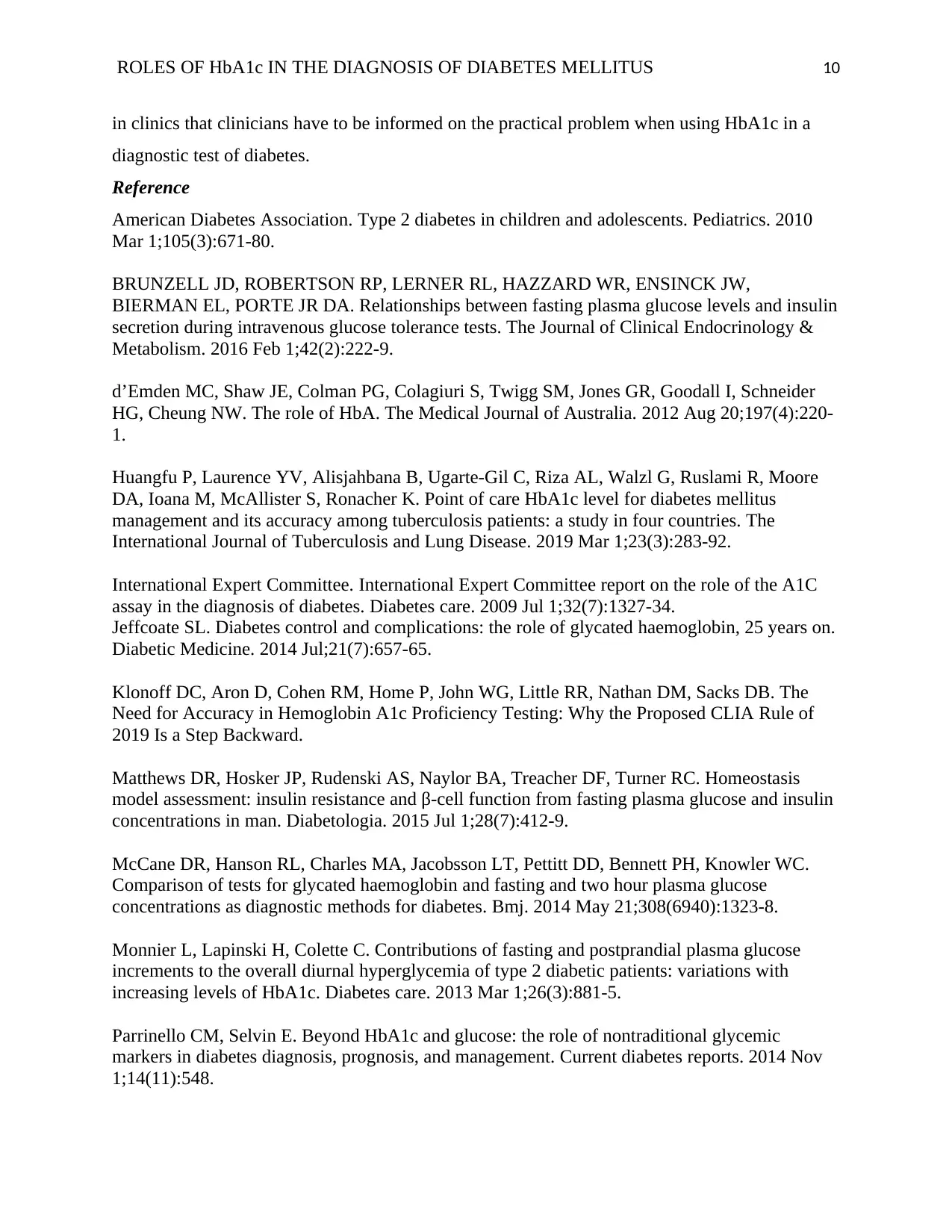
ROLES OF HbA1c IN THE DIAGNOSIS OF DIABETES MELLITUS 10
in clinics that clinicians have to be informed on the practical problem when using HbA1c in a
diagnostic test of diabetes.
Reference
American Diabetes Association. Type 2 diabetes in children and adolescents. Pediatrics. 2010
Mar 1;105(3):671-80.
BRUNZELL JD, ROBERTSON RP, LERNER RL, HAZZARD WR, ENSINCK JW,
BIERMAN EL, PORTE JR DA. Relationships between fasting plasma glucose levels and insulin
secretion during intravenous glucose tolerance tests. The Journal of Clinical Endocrinology &
Metabolism. 2016 Feb 1;42(2):222-9.
d’Emden MC, Shaw JE, Colman PG, Colagiuri S, Twigg SM, Jones GR, Goodall I, Schneider
HG, Cheung NW. The role of HbA. The Medical Journal of Australia. 2012 Aug 20;197(4):220-
1.
Huangfu P, Laurence YV, Alisjahbana B, Ugarte-Gil C, Riza AL, Walzl G, Ruslami R, Moore
DA, Ioana M, McAllister S, Ronacher K. Point of care HbA1c level for diabetes mellitus
management and its accuracy among tuberculosis patients: a study in four countries. The
International Journal of Tuberculosis and Lung Disease. 2019 Mar 1;23(3):283-92.
International Expert Committee. International Expert Committee report on the role of the A1C
assay in the diagnosis of diabetes. Diabetes care. 2009 Jul 1;32(7):1327-34.
Jeffcoate SL. Diabetes control and complications: the role of glycated haemoglobin, 25 years on.
Diabetic Medicine. 2014 Jul;21(7):657-65.
Klonoff DC, Aron D, Cohen RM, Home P, John WG, Little RR, Nathan DM, Sacks DB. The
Need for Accuracy in Hemoglobin A1c Proficiency Testing: Why the Proposed CLIA Rule of
2019 Is a Step Backward.
Matthews DR, Hosker JP, Rudenski AS, Naylor BA, Treacher DF, Turner RC. Homeostasis
model assessment: insulin resistance and β-cell function from fasting plasma glucose and insulin
concentrations in man. Diabetologia. 2015 Jul 1;28(7):412-9.
McCane DR, Hanson RL, Charles MA, Jacobsson LT, Pettitt DD, Bennett PH, Knowler WC.
Comparison of tests for glycated haemoglobin and fasting and two hour plasma glucose
concentrations as diagnostic methods for diabetes. Bmj. 2014 May 21;308(6940):1323-8.
Monnier L, Lapinski H, Colette C. Contributions of fasting and postprandial plasma glucose
increments to the overall diurnal hyperglycemia of type 2 diabetic patients: variations with
increasing levels of HbA1c. Diabetes care. 2013 Mar 1;26(3):881-5.
Parrinello CM, Selvin E. Beyond HbA1c and glucose: the role of nontraditional glycemic
markers in diabetes diagnosis, prognosis, and management. Current diabetes reports. 2014 Nov
1;14(11):548.
in clinics that clinicians have to be informed on the practical problem when using HbA1c in a
diagnostic test of diabetes.
Reference
American Diabetes Association. Type 2 diabetes in children and adolescents. Pediatrics. 2010
Mar 1;105(3):671-80.
BRUNZELL JD, ROBERTSON RP, LERNER RL, HAZZARD WR, ENSINCK JW,
BIERMAN EL, PORTE JR DA. Relationships between fasting plasma glucose levels and insulin
secretion during intravenous glucose tolerance tests. The Journal of Clinical Endocrinology &
Metabolism. 2016 Feb 1;42(2):222-9.
d’Emden MC, Shaw JE, Colman PG, Colagiuri S, Twigg SM, Jones GR, Goodall I, Schneider
HG, Cheung NW. The role of HbA. The Medical Journal of Australia. 2012 Aug 20;197(4):220-
1.
Huangfu P, Laurence YV, Alisjahbana B, Ugarte-Gil C, Riza AL, Walzl G, Ruslami R, Moore
DA, Ioana M, McAllister S, Ronacher K. Point of care HbA1c level for diabetes mellitus
management and its accuracy among tuberculosis patients: a study in four countries. The
International Journal of Tuberculosis and Lung Disease. 2019 Mar 1;23(3):283-92.
International Expert Committee. International Expert Committee report on the role of the A1C
assay in the diagnosis of diabetes. Diabetes care. 2009 Jul 1;32(7):1327-34.
Jeffcoate SL. Diabetes control and complications: the role of glycated haemoglobin, 25 years on.
Diabetic Medicine. 2014 Jul;21(7):657-65.
Klonoff DC, Aron D, Cohen RM, Home P, John WG, Little RR, Nathan DM, Sacks DB. The
Need for Accuracy in Hemoglobin A1c Proficiency Testing: Why the Proposed CLIA Rule of
2019 Is a Step Backward.
Matthews DR, Hosker JP, Rudenski AS, Naylor BA, Treacher DF, Turner RC. Homeostasis
model assessment: insulin resistance and β-cell function from fasting plasma glucose and insulin
concentrations in man. Diabetologia. 2015 Jul 1;28(7):412-9.
McCane DR, Hanson RL, Charles MA, Jacobsson LT, Pettitt DD, Bennett PH, Knowler WC.
Comparison of tests for glycated haemoglobin and fasting and two hour plasma glucose
concentrations as diagnostic methods for diabetes. Bmj. 2014 May 21;308(6940):1323-8.
Monnier L, Lapinski H, Colette C. Contributions of fasting and postprandial plasma glucose
increments to the overall diurnal hyperglycemia of type 2 diabetic patients: variations with
increasing levels of HbA1c. Diabetes care. 2013 Mar 1;26(3):881-5.
Parrinello CM, Selvin E. Beyond HbA1c and glucose: the role of nontraditional glycemic
markers in diabetes diagnosis, prognosis, and management. Current diabetes reports. 2014 Nov
1;14(11):548.
Paraphrase This Document
Need a fresh take? Get an instant paraphrase of this document with our AI Paraphraser
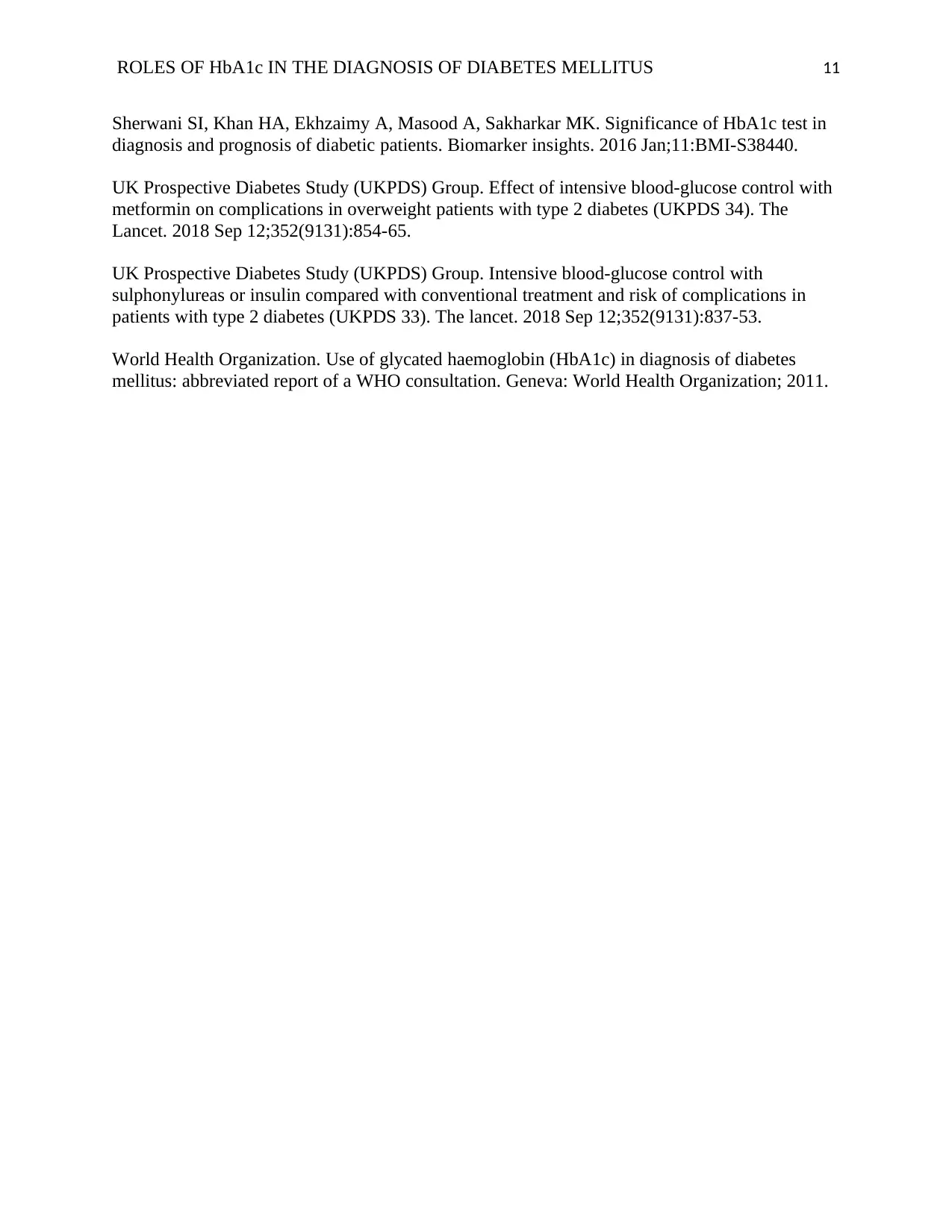
ROLES OF HbA1c IN THE DIAGNOSIS OF DIABETES MELLITUS 11
Sherwani SI, Khan HA, Ekhzaimy A, Masood A, Sakharkar MK. Significance of HbA1c test in
diagnosis and prognosis of diabetic patients. Biomarker insights. 2016 Jan;11:BMI-S38440.
UK Prospective Diabetes Study (UKPDS) Group. Effect of intensive blood-glucose control with
metformin on complications in overweight patients with type 2 diabetes (UKPDS 34). The
Lancet. 2018 Sep 12;352(9131):854-65.
UK Prospective Diabetes Study (UKPDS) Group. Intensive blood-glucose control with
sulphonylureas or insulin compared with conventional treatment and risk of complications in
patients with type 2 diabetes (UKPDS 33). The lancet. 2018 Sep 12;352(9131):837-53.
World Health Organization. Use of glycated haemoglobin (HbA1c) in diagnosis of diabetes
mellitus: abbreviated report of a WHO consultation. Geneva: World Health Organization; 2011.
Sherwani SI, Khan HA, Ekhzaimy A, Masood A, Sakharkar MK. Significance of HbA1c test in
diagnosis and prognosis of diabetic patients. Biomarker insights. 2016 Jan;11:BMI-S38440.
UK Prospective Diabetes Study (UKPDS) Group. Effect of intensive blood-glucose control with
metformin on complications in overweight patients with type 2 diabetes (UKPDS 34). The
Lancet. 2018 Sep 12;352(9131):854-65.
UK Prospective Diabetes Study (UKPDS) Group. Intensive blood-glucose control with
sulphonylureas or insulin compared with conventional treatment and risk of complications in
patients with type 2 diabetes (UKPDS 33). The lancet. 2018 Sep 12;352(9131):837-53.
World Health Organization. Use of glycated haemoglobin (HbA1c) in diagnosis of diabetes
mellitus: abbreviated report of a WHO consultation. Geneva: World Health Organization; 2011.
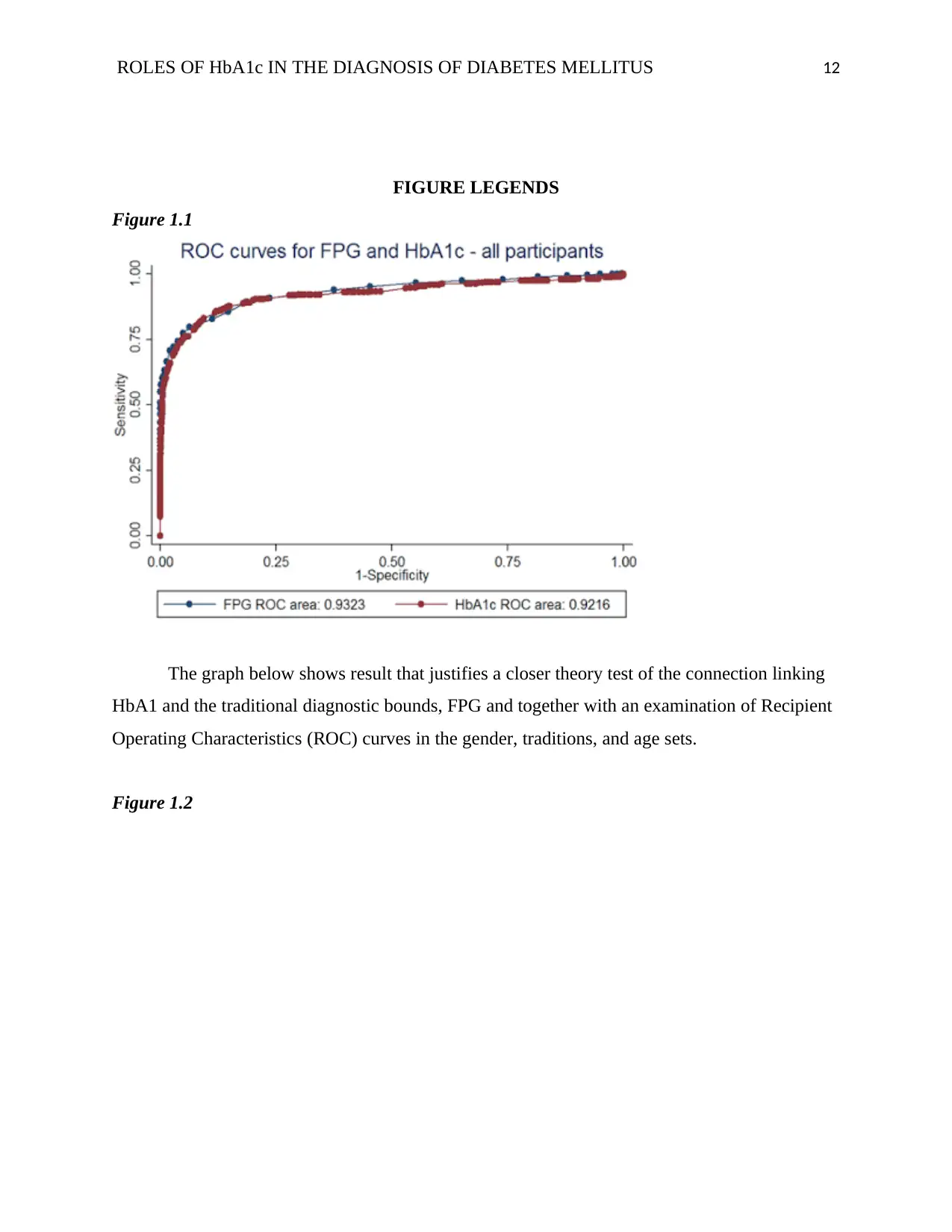
ROLES OF HbA1c IN THE DIAGNOSIS OF DIABETES MELLITUS 12
FIGURE LEGENDS
Figure 1.1
The graph below shows result that justifies a closer theory test of the connection linking
HbA1 and the traditional diagnostic bounds, FPG and together with an examination of Recipient
Operating Characteristics (ROC) curves in the gender, traditions, and age sets.
Figure 1.2
FIGURE LEGENDS
Figure 1.1
The graph below shows result that justifies a closer theory test of the connection linking
HbA1 and the traditional diagnostic bounds, FPG and together with an examination of Recipient
Operating Characteristics (ROC) curves in the gender, traditions, and age sets.
Figure 1.2
⊘ This is a preview!⊘
Do you want full access?
Subscribe today to unlock all pages.

Trusted by 1+ million students worldwide
1 out of 15
Your All-in-One AI-Powered Toolkit for Academic Success.
+13062052269
info@desklib.com
Available 24*7 on WhatsApp / Email
![[object Object]](/_next/static/media/star-bottom.7253800d.svg)
Unlock your academic potential
Copyright © 2020–2025 A2Z Services. All Rights Reserved. Developed and managed by ZUCOL.
